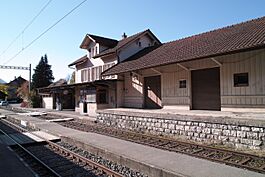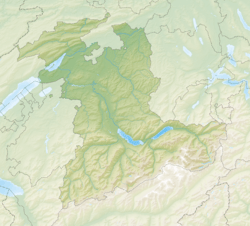Court, Switzerland facts for kids
Quick facts for kids
Court
|
||
|---|---|---|

Court railroad station
|
||
|
||
| Country | Switzerland | |
| Canton | Bern | |
| District | Jura bernois | |
| Area | ||
| • Total | 24.61 km2 (9.50 sq mi) | |
| Elevation | 666 m (2,185 ft) | |
| Population
(Dec 2020 )
|
||
| • Total | 1,417 | |
| • Density | 57.58/km2 (149.13/sq mi) | |
| Postal code |
2738
|
|
| Surrounded by | Romont, Sorvilier, Champoz, Moutier, Eschert, Gänsbrunnen, Selzach, Grenchen | |
Court is a small town, also called a municipality, in Switzerland. It is located in the canton of Bern, in an area called Jura bernois. This part of Switzerland mainly speaks French.
Contents
History of Court
Court was first written about in the year 1148. Back then, it was called Cort.
Early Villages and Changes
Between the 1100s and 1400s, there was another village nearby called Mévilier. It was located between Court and Champoz. For some reason, Mévilier was left empty in the 1400s. For a long time, Court was part of a larger area called Orval. This area was owned by the leader of Moutier-Grandval Abbey, who was called a provost.
Becoming Part of France and Switzerland
In 1797, France won a war and Court became part of France. It was first in a French area called Mont-Terrible. Then, in 1800, it moved to another French area called Haut-Rhin. After Napoleon lost power, Court became part of the Canton of Bern in Switzerland in 1815.
Religious Changes
Court was originally part of the church area of Mévilier. By the 1500s, it joined the church area of Sorvilier. In 1531, Court changed its religion to Protestantism. The old church in Mévilier was still used by people from Court until about 1715. Later, people from Court went to a church in a village called Vélé. Finally, in 1864, Court got its own church.
Growth and Industry
In the Middle Ages, Court had sawmills, mines, and places to melt metal. In 1658, there were four glass blowing workshops in a village nearby called le Chaluet. These workshops worked until 1738. Around the late 1700s, people in Court started making pottery.
A big road was built through the Court Gorge in 1752. This road helped connect Court to other parts of the country and allowed it to grow. A train station was built in 1877, connecting Court to Delémont, Sonceboz, and Biel. From 1911 to 1916, a tunnel was built through the Jura Mountains. This tunnel linked Court to Moutier and Grenchen. These good transport links helped small factories come to Court. In the late 1800s, companies making machines, watches, and other engineered products moved here. Today, most workers in Court work in factories, usually in small companies.
Geography of Court
Court covers an area of about 24.60 square kilometers (9.5 square miles).
Land Use
About 34.3% of the land is used for farming. Forests cover about 60% of the area. Buildings and roads take up about 4.6% of the land. A very small part, 0.1%, is rivers or lakes. The remaining 0.9% is land that cannot be used for farming or building.
Most of the forested land is thick forest. A small part has fruit trees or small groups of trees. For farming, some land is used for growing crops. Other parts are used for pastures where animals graze.
Location and Features
Court is a linear village. This means it is spread out in a line along a road or river. It is in the eastern part of the Vallée de Tavannes. The Birs River flows through the Court Canyon, which is near the village. Court also includes about a dozen farmhouses in areas like le Chaluet, Graitery, Mont Girod, and Montoz.
Future Plans
The towns of Bévilard, Court, Malleray, Pontenet, and Sorvilier are thinking about joining together. If they do, they would form a new town called Valbirse. This could happen on January 1, 2015.
Court's old district, District de Moutier, ended on December 31, 2009. The next day, it became part of a new area called Arrondissement administratif Jura bernois.
Coat of Arms
The blazon (description) of Court's town symbol is: Azure a Horn Or ringed Argent and stringed Gules and a Chief of the first three pales Or. This means it has a blue background. On it is a golden horn with a silver ring and red string. At the top, there are three golden stripes on a blue background.
People in Court (Demographics)
Court has a population of about 1,382 people. As of 2010, about 6% of the people living in Court are from other countries. Over the past 10 years, the number of people in Court has changed a little.
Languages Spoken
Most people in Court speak French. About 89.1% of the population speaks French as their first language. The second most common language is German, spoken by about 6.6% of the people. About 1% of the people speak Portuguese. A few people also speak Italian or Romansh.
Who Lives in Court?
As of 2008, about 48.7% of the population were boys and men. About 51.3% were girls and women. Most people living in Court were born there or in the same canton. About 10.7% were born outside Switzerland.
In 2011, children and teenagers (0–19 years old) made up 23.2% of the population. Adults (20–64 years old) made up 56.9%. Older people (over 64 years old) made up 19.9%.
Homes in Court
As of 2010, there were 170 homes where only one person lived. There were also 46 homes with five or more people. In 2000, most apartments (87%) were lived in all the time. Some were used only at certain times of the year, and a few were empty.
The historical population is shown in the chart below:

Economy of Court
In 2011, the unemployment rate in Court was low, at 1.75%. This means most people who wanted a job had one.
Jobs and Industries
As of 2008, 669 people worked in Court.
- Primary sector: 76 people worked in this sector. This includes jobs like farming and forestry. There were about 27 businesses in this area.
- Secondary sector: 432 people worked in this sector. This includes jobs in manufacturing (making things) and construction (building things). There were 36 businesses here. Most of these jobs (95.4%) were in manufacturing.
- Tertiary sector: 161 people worked in this sector. This includes jobs that provide services. There were 39 businesses here. Examples include sales, transport, hotels, restaurants, healthcare, and education.
About 42.7% of the workers in Court were women.
Commuting and Taxes
In 2000, many people traveled into Court for work (376 workers). Fewer people traveled out of Court for work (286 workers). This means Court has more jobs than people living there who work. About 51.4% of workers in Court also lived there.
In 2011, the average tax rate for a married person with two children in Court was 13.3%. For a single person, it was 19.5%. These rates were a bit lower than the average for the whole canton of Bern.
Religion in Court
Based on a 2000 survey, about 52.9% of people in Court belonged to the Swiss Reformed Church (a Protestant church). About 20.2% were Roman Catholic.
About 14.83% of the population belonged to other Christian churches. About 1.63% were Muslim. Around 7.26% of people did not belong to any church, or were agnostic or atheist.
Education in Court
In Court, about 56.8% of people have finished non-mandatory higher schooling. This means they went to school beyond the basic required years. About 9.1% have completed even higher education, like university.
School System
The school system in the Canton of Bern starts with one year of optional Kindergarten. After that, there are six years of Primary school. Then, students go to three years of required lower Secondary school. In secondary school, students are grouped by their abilities. After lower Secondary school, students can continue their education or start an apprenticeship (learning a trade on the job).
Students in Court
During the 2011-2012 school year, 112 students went to school in Court. There were 2 kindergarten classes with 31 students. In kindergarten, some students (6.5%) were not Swiss citizens, and some (12.9%) spoke a different language at home than in class. There were 4 primary classes with 81 students. In primary school, 4.9% of students were not Swiss citizens, and 7.4% spoke a different language at home.
In 2000, 101 students lived and went to school in Court. However, 94 students from Court went to schools outside the town.
Transportation
Court has its own train station, called Court. This station is on the Sonceboz-Sombeval–Moutier line. Trains regularly go from Court to Biel/Bienne and Moutier.
Images for kids
See also
 In Spanish: Court para niños
In Spanish: Court para niños







